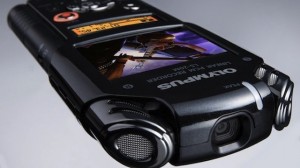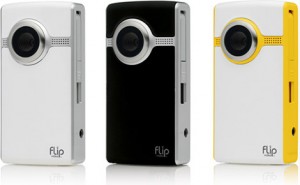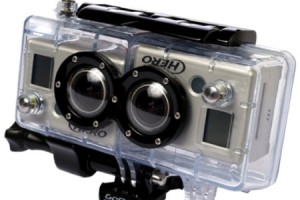By
ETCentric StaffFebruary 13, 2024
In the wake of the recent Vision Pro launch, mostly positive reviews, and (reportedly) selling out of its modest 200,000 unit initial production run, Apple seems to have reignited its appetite for innovation. The company is said to be considering the release of a foldable iPhone after quietly developing the technology since 2018. A sticking point for the design-oriented firm may be the “ubiquitous foldable crease,” which has pundits speculating that Apple’s debut entry won’t hit the market before 2026. Early reports suggest the company is pursuing a clamshell form factor that folds lengthwise. Continue reading Is Foldable iPhone What’s Next for Apple After the Vision Pro?
By
Rob ScottFebruary 5, 2014
GoPro has become a leader in small, rugged, low-cost video cameras especially useful for extreme sports, documentaries and reality TV. User-generated content recorded on GoPro cameras has exploded on YouTube and other sites. Millions of professional and amateur users have posted videos online, often proudly labeling content with the term “GoPro,” which has become synonymous with action footage. Now GoPro has plans to become a media company. Continue reading GoPro Looks Beyond Action Cam to Establishing Media Brand
By
Rob ScottJune 16, 2011
- Toshiba recently announced two new additions to its Camileo line of pocket digital camcorders.
- The 3-ounce Camileo B10 ($120) offers FullHD 1080P and a 16x digital zoom.
- The 4.7-ounce Camileo P100 ($180) also offers FullHD 1080P, plus a 5x optical zoom and 8x advanced zoom in video mode.
- Both are Windows- and and Mac-compatible.
Is the demise of the Flip good news for the Camileo line and others such as GoPro, Creative Vado, Kodak Playfull and Sony Bloggie?

This week, Olympus announced its new LS-20M pocket camcorder that boasts 1080p HD video recording and 24 bit/96 hHz linear PCM audio recording using two condenser mics. Engadget reports that the handheld’s “relatively high-end audio specs should help it go toe-to-toe with Zoom.” (The $300 Zoom Q3HD Handy Video Recorder was introduced late last year.)
 According to the Olympus press release: “The HD video compression format makes it easy to upload videos to Facebook, YouTube, iTunes, Vimeo and other web-based content sharing sites, and the resolution offers remarkable detail on modern home theatre systems.” The LS-20M can record audio in stereo as WAV and MP3 formats. It is 5.3 inches in length and weighs 5.4 ounces.
According to the Olympus press release: “The HD video compression format makes it easy to upload videos to Facebook, YouTube, iTunes, Vimeo and other web-based content sharing sites, and the resolution offers remarkable detail on modern home theatre systems.” The LS-20M can record audio in stereo as WAV and MP3 formats. It is 5.3 inches in length and weighs 5.4 ounces.
The new camcorder also includes “Magic Movie” special effects settings such as Rock, Sketch, Pinhole and Pop.
In the wake of Cisco’s announcement to discontinue the Flip camera line, the Olympus LS-20M is a potential replacement for consumers and a possible new tool for mobile reporting. The device will be available by June 2011 for MSRP of $300.
Related Olympus press release: “New Olympus LS-20M Unites High-Definition Video and PCM Audio to Capture Sights and Sounds Like Never Before” (5/3/11)
Related Engadget post: “Zoom’s dual mic-equipped Q3HD camcorder now available for $300” (11/2/10)

By
Rob ScottApril 19, 2011
According to Flickr’s “camera finder” feature, the iPhone 4 is heading towards becoming the most popular “camera” used to submit images to the photo-sharing site. Is the iPhone (and other smartphones with improved camera features) disrupting the point-and-shoot market?
Flickr’s camera finder provides a graph detailing the most popular cameras in the Flickr community, with the Nikon D90 currently at the top. However, the iPhone 4 is on the rise, while traditional point-and-shoot cameras are steadily declining. If the trend continues, the iPhone is poised to take the lead in the near future.
This isn’t the first time a phone may prove more popular than a traditional camera on Flickr. PC World reports that in August 2009, the iPhone edged by the Canon Digital Rebel XTi as the most popular (back when the best iPhone camera only featured 3.2-megapixel resolution).
We recently reported that Cisco had shut down production on the popular Flip camera line, possibly in response to smartphones’ ability to shoot HD video. Is the iPhone still proving disruptive, four years after its initial release? According to GigaOM: “The takeaway is that smartphones are nearing the tipping point in terms of camera quality when it comes to the needs of most average users (professional and prosumer DSLRs continue to do well), and the iPhone 4 is leading that charge. Phones provide a much more convenient on-hand camera experience than do dedicated devices, and the trade-offs in terms of quality and feature are becoming less significant all the time.”
Related PC World story: “iPhone 4 About to Be Most Popular Camera on Flickr” (4/18/11)

By
Rob ScottApril 13, 2011
Wired comments on the demise of the Flip camcorder and questions what could have been done to possibly revive Cisco’s $590 million investment in the no-frills digital video camera (Cisco purchased Flip-maker Pure Digital in March 2009). Wired reports that in the wake of company earnings falling 18 percent in the second quarter of 2011, Cisco will pull the plug on Flip.
 In related news, The Wall Street Journal reports Cisco CEO John Chambers has announced a strategic shift at the company that will involve stepping away from consumer-targeted brands and returning to a focus on corporate customers and service providers.
In related news, The Wall Street Journal reports Cisco CEO John Chambers has announced a strategic shift at the company that will involve stepping away from consumer-targeted brands and returning to a focus on corporate customers and service providers.
Flip cameras were all the rage in their heyday and spawned a number of similar products from the likes of Kodak and Sony geared toward consumers who wanted to shoot simple video and easily upload clips to the Internet. An unanticipated result of the camera’s portability and durability included uses such as capturing extreme sports footage and gathering b-roll for broadcast news. Affordable mounts for helmets and motorcycles soon emerged, as well as waterproof casings for recording underwater footage, increasing the line’s popularity. So what happened?
Wired suggests that once iPhones and Android phones started offering improved camera capabilities, including HD video recording, the Flip cameras started down a path of redundancy. Second, came the shift to real-time social networking — and without an Internet connection, Flip had trouble competing with other connected portable devices. Consumers began to expect immediacy in terms of media interaction and the ability to post their own content on-the-go.
A Wi-Fi or 3G connection may have been the first step in keeping the Flip alive, but in today’s market it would probably also need a touchscreen with apps to compete.
Related Story: David Pogue offers a different take on the camera line — “The Tragic Death of the Flip” (4/14/11)
UPDATE: Related press release — “Cisco Announces Streamlined Operating Model” (5/5/11)

By
Rob ScottApril 11, 2011
GoPro is gaining in consumer popularity thanks to its collection of Hero Camera mounts that allow users to attach inexpensive cameras to everything from ski helmets to the tips of surfboards for action footage. Already popular with skiers, snowboarders, surfers, bikers and other outdoor enthusiasts and extreme athletes, the GoPro line is starting to become more common with professional cameramen as well. Nature photographers, in particular, are using GoPro products to shoot footage of hard-to-reach places, such as inside a cobra’s den or a shark’s mouth.
 The small, six-ounce, 1080p camera comes with a water-tight housing and starts at $260.
The small, six-ounce, 1080p camera comes with a water-tight housing and starts at $260.
GoPro’s parent company, Woodman Labs Inc., is receiving funding from outside investors, including Steamboat Ventures, a venture capital fund backed by Disney (Steamboat Ventures was also an investor in Pure Digital, maker of the popular Flip pocket camcorder). Steamboat plans to help GoPro expand further into the professional market.
Gizmodo offers a positive review of the 3D Hero System — a $99 3D kit (cameras not included) that GoPro bills as “the world’s smallest 1080p 3D camera.” The system combines two HD cameras in a waterproof housing that enables users to shoot synchronized photos and video (2D and 3D) that can then be edited in 3D with the free CineForm Studio software.
Most helmet and similar cameras have gone to wide angle lenses to ensure footage and minimize shake. The result was effective, but made things look smaller when viewed. Gizmodo notes that “adding 3D gives depth to the trees and objects rushing past you,” providing for a more immersive viewing experience.
You can check out the GoPro video demo to see how the 3D Hero System works.
Related Wall Street Journal story: “Camcorder Popular With Surfers Looks to Ride Professional Market” (4/6/11)






